

Public transport in and about the parish
It
is a perilous enterprise to write about public transport, since there
are so many enthusiasts and minutely-detailed websites out there, but
it's part of the story of the parish past and present - affecting where
people live and work, and increasingly house prices - so here goes.
Of course,
for most of the history of the parish people walked
everywhere - to work, for leisure, to visit family and friends - often
covering long distances. Many continued to do so even when cheap
transport, on trains (with workmen's tickets) and trams and buses,
became available, to save a halfpenny or a penny fare. But, as other
pages on this site show, for parish trips and outings to the country or
the seaside the possibilities of public transport were enthusiastically
embraced. So was the bicycle,
in a mainly flat area; and this means of transport is
increasingly popular today. In preparation for the Olympics, CABLE STREET has
recently become part of CS3, a Cycle Super Highway from Tower Gateway
to Alfred's Way (A13) in Barking, linking with other routes.
Unfortunately they are painted bright blue, rather than the friendlier
and traditional green, at the sponsors' behest.
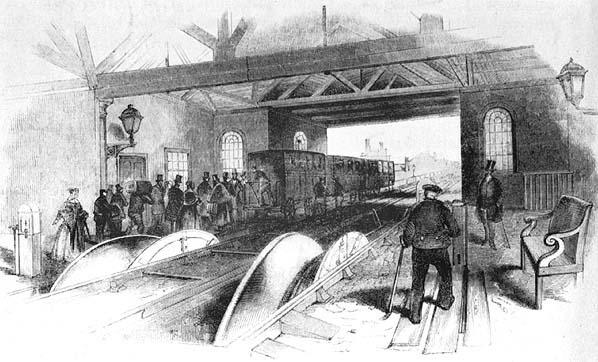 London and Blackwall Railway
London and Blackwall Railway
As
early as 1836, Parliament gave authority - despite considerable
local opposition - for the construction of The Commercial Railway, to
run 3½ miles on viaducts from Minories to Blackwall, bisecting the
parish from from west to east. Robert Stephenson (son of George)
became the engineer; he had to follow the route, and the eccentric 5'
½" gauge, of his predecessor, but opted for a cable-hauled system with
stationary engines at Minories [pictured] :
a 7-mile hemp (later steel) rope slipped off carriage at each station
on the outward run and picked them up on return. Because of the fare
for the full journey it became known as the 'Fourpenny Rope'. It opened in 1840; when a new terminus at Fenchurch Street was built the following year, its name was changed to the London and Blackwall Railway. But
the cable system failed; the line was converted to standard gauge with
steam engines, lighter than the normal suburban stock, in 1849, making
possible extensions to Bow and to the London, Tilbury and Southend
Railway.
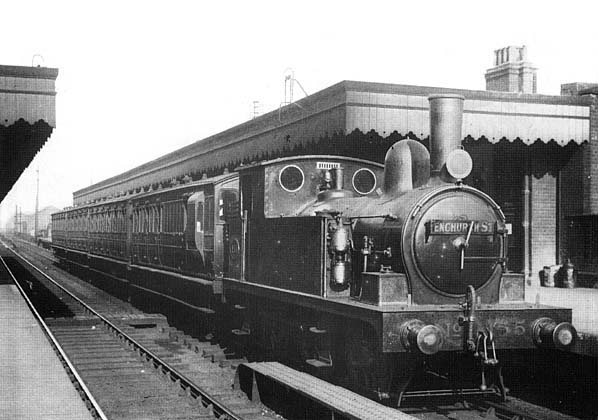 |
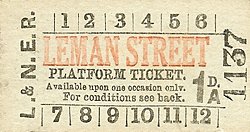 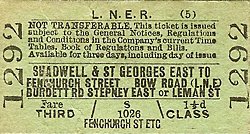 |
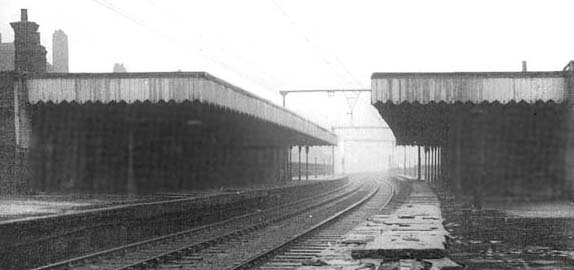 |
There were three stations in the parish - Leman Street (1877-1941) [pictured left], replacing Cannon Street Road (1842-48), of which no trace remains, and Shadwell & St George-in-the-East (1840-1941) [pictured right]. The railway arches came to house a variety of workshops and other uses - including, as described HERE, schools, and houses were built right up against the viaduct, which had metal railings rather than a brick wall, as this was deemed to be quieter for passengers and adjacent properties. In 1893 the line from Fenchurch Street to Stepney [now Limehouse] was widened to four tracks, though soon after traffic declined.
In
recent times, two of the tracks between Tower Gateway and Limehouse
have been used for the Docklands Light Railway - see below - with a new
station at Shadwell.
East London Line / London Overground
It began
as the East London Railway, run from 1869 by a consortium of six
companies who took over Brunel's Thames Tunnel between Wapping and
Rotherhithe (built between 1825 and 1843), so it incorporates the
oldest tunnels on the underground network. A triumph of civil
engineering, designed for horse-drawn traffic, Brunel's tunnel proved a commercial
flop and was only used by pedestrians; but it was strategically
placed to provide a service, without the expense of a new river crossing,
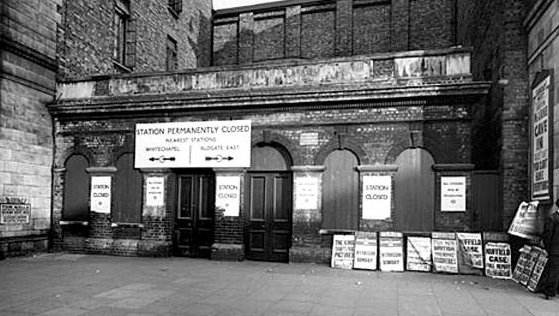 running close to the docks on both sides of
the river
running close to the docks on both sides of
the riverIt was originally worked by steam – hence the large open ventilation shafts at Shadwell and other stations.
The line
has been twice closed for extensive rebuilding work in recent times,
but reopened in 2010 as part of London Overground, with a view to
creating an 'Outer Circle' in time for the Olympics. New stations
have been built at Shoreditch (unfortunately not connecting with the
Central Line, which runs directly beneath) and beyond, via a new viaduct to connect with the old
Broad Street lines, and in due course it will connect directly in the north to
the network at Highbury and Islington, and in the south to Clapham
Junction.
Pictured
is the old Shadwell ticket hall on Watney Street, demolished in the
summer of 2010; the Cable Street entrance before the most recent
closure; the
new ticket hall (which has
entrances on Cable Street and Chapman Street); and the rolling stock
now used on this line.
|
|
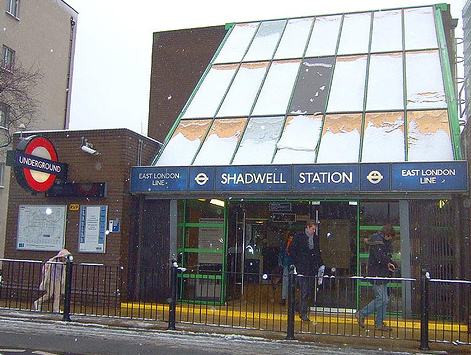 |
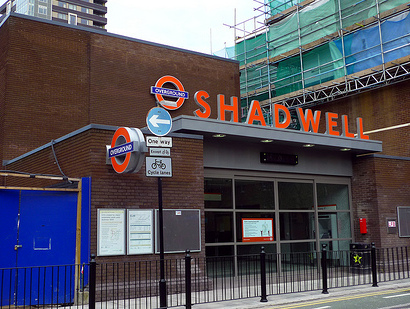 |
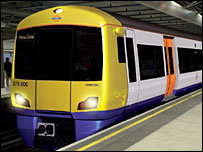 |
Although transfer on the same ticket between Overground and DLR at Shadwell is possible, the two stations, though adjacent, remain separate. It is a pity that the opportunity to construct a proper interchange was not taken, especially as the DLR station has also recently been remodelled (see below). Nor was full disabled access between the lifts and the platforms achieved, at Shadwell, Wapping and Rotherhithe, because (it is claimed) of the constraints of space.
Sarah McMenemy's art work - enamelled panels of local scenes - remains on the platforms at Shadwell. The picture of our church is HERE, and more examples of her work can be seen here.
With the
re-opening of the line, one pub quiz question comes back to life:
| Which tube station has no letters in common with the word 'lobster'? |
and one
new one is created:
| At which station does London Overground run beneath London Underground? |
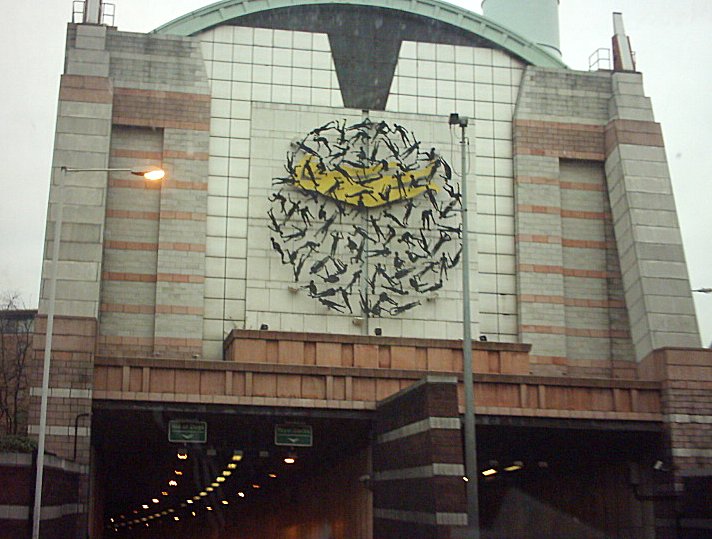 Trams, trolleybuses and buses
Trams, trolleybuses and buses
Old water troughs at road junctions are a sure sign of historic horse-drawn routes, some of which are little-changed today. There are none locally, but long-established routes through the parish nevertheless remain. They go along Commercial Road, its northern boundary; although The Highway is now an extremely busy road, used by many airport and other coaches, this has only been the case since the opening of the Limehouse Link tunnel [western entrance pictured], built between 1989-93 to link the City to Docklands, and the only TfL bus route to run along it (apart from short stretches of the D3 and 100) is night bus N551, from Trafalgar Square to Gallions Reach.
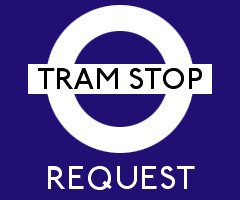 Electric
trams were introduced to London at the start of the 20th century and
became popular – by 1914 it was the largest network in Europe,
though the First World War, and legal restrictions, halted further
significant growth. Two routes ran from Aldgate along Commercial
Road, the 65 from Bloomsbury to Poplar, and the 67 from Aldgate to
Barking [despite the picture below]. Another route, the 47, ran north-south, from Stamford Hill
to London Docks, running down Leman Street to a 'grim and desolate' terminus in Dock Street,
and was well-used by dock workers.
Electric
trams were introduced to London at the start of the 20th century and
became popular – by 1914 it was the largest network in Europe,
though the First World War, and legal restrictions, halted further
significant growth. Two routes ran from Aldgate along Commercial
Road, the 65 from Bloomsbury to Poplar, and the 67 from Aldgate to
Barking [despite the picture below]. Another route, the 47, ran north-south, from Stamford Hill
to London Docks, running down Leman Street to a 'grim and desolate' terminus in Dock Street,
and was well-used by dock workers.
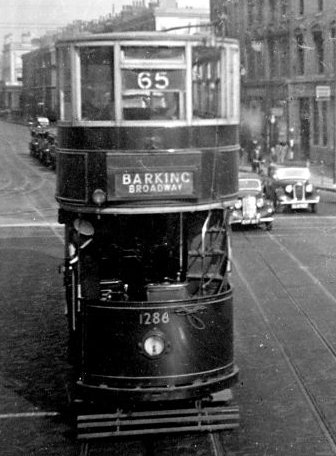 |
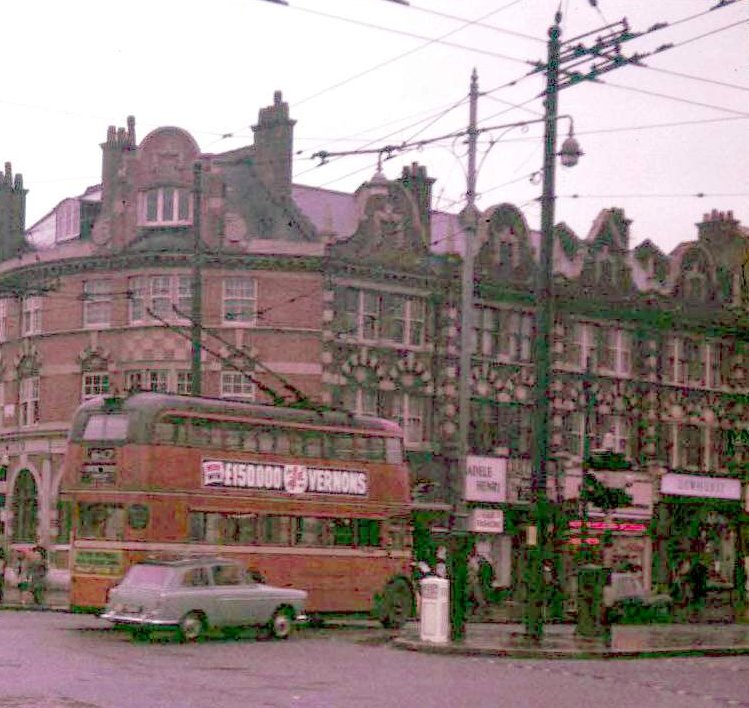 |
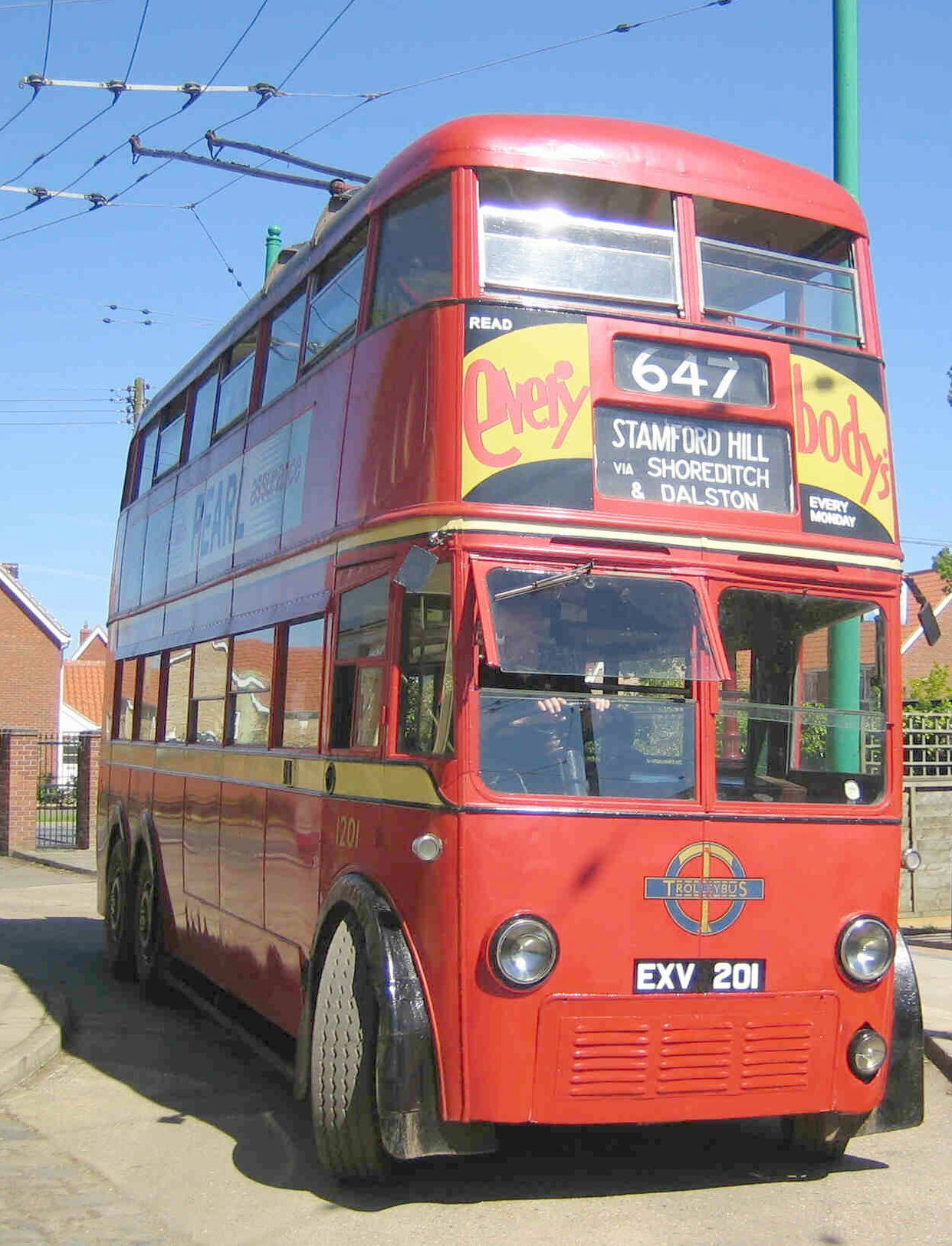 |
 A Royal
Commission in 1931 recommended replacing trams with trolleybuses,
mainly because tramlines and stops in the middle of narrow London streets added to
the increasing traffic congestion. By 1940 half the trams had been
scrapped (compare maps for 1934 and 1940). So the 47 tram became the 647
trolleybus [pictured above at Stamford Hill, and a preserved vehicle at the East Anglia Transport Museum], the 65 tram the 665 trolleybus, and the 67 tram the 567
trolleybus, in line with the numbering system:
A Royal
Commission in 1931 recommended replacing trams with trolleybuses,
mainly because tramlines and stops in the middle of narrow London streets added to
the increasing traffic congestion. By 1940 half the trams had been
scrapped (compare maps for 1934 and 1940). So the 47 tram became the 647
trolleybus [pictured above at Stamford Hill, and a preserved vehicle at the East Anglia Transport Museum], the 65 tram the 665 trolleybus, and the 67 tram the 567
trolleybus, in line with the numbering system:
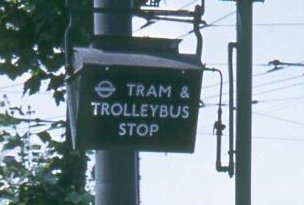 The 1924
London Traffic Act had created a system of route numbering, called
the Bassom Scheme, after the chief constable of the Metropolitan
Police, whereby letters were added after the number to denote
part-routes. When London Transport was formed in 1934, the system was
changed again, though letter suffixes continued. Routes 1-199 were
central-area red double decker buses, 200-299 single decker and night
routes, 300-499 country buses south and north of the river, 500-699
trolleybuses and 700-899 Green Line coaches and routes in new towns.
'London Transport' has continued under various names and organisational guises
ever since. (There was reluctance, led by teetotal members of
the London County Council, to allow pub names on bus blinds, so
less-familiar street names appeared instead.) The 1924
London Traffic Act had created a system of route numbering, called
the Bassom Scheme, after the chief constable of the Metropolitan
Police, whereby letters were added after the number to denote
part-routes. When London Transport was formed in 1934, the system was
changed again, though letter suffixes continued. Routes 1-199 were
central-area red double decker buses, 200-299 single decker and night
routes, 300-499 country buses south and north of the river, 500-699
trolleybuses and 700-899 Green Line coaches and routes in new towns.
'London Transport' has continued under various names and organisational guises
ever since. (There was reluctance, led by teetotal members of
the London County Council, to allow pub names on bus blinds, so
less-familiar street names appeared instead.) |
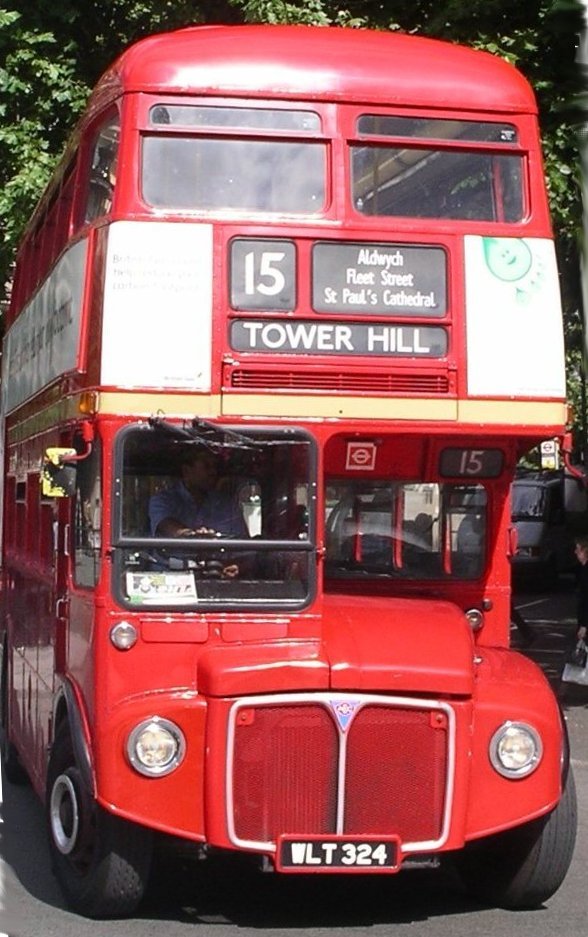 Trolleybuses
were silent, and could accelerate quickly - both of which were seen by
some as dangerous! Despite their good performance, from
1959-92 trolleybuses were in turn phased out, and replaced by large
numbers of new Routemaster buses.
Trolleybuses
were silent, and could accelerate quickly - both of which were seen by
some as dangerous! Despite their good performance, from
1959-92 trolleybuses were in turn phased out, and replaced by large
numbers of new Routemaster buses.
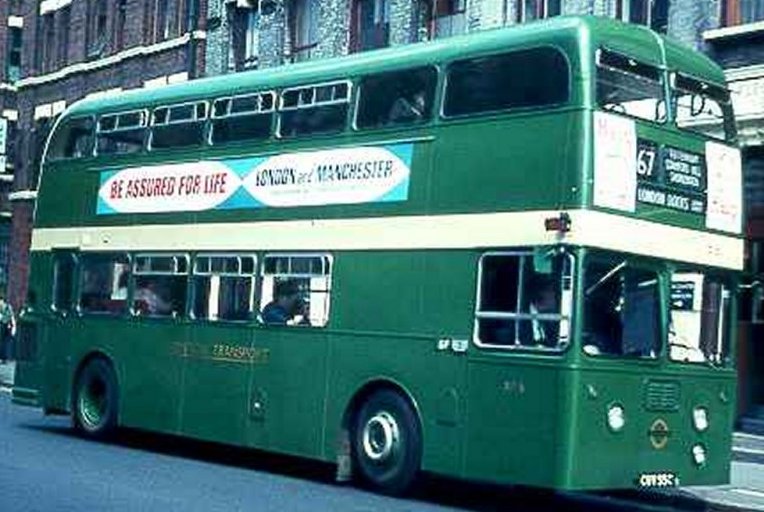 The 567 and 665 routes went in
December 1959, replaced by a new 5 and 5A bus service (later confined
to the eastern parts of the route) and the strengthening of existing
routes 15, 23 and 40. The 647 lasted a further two years, before
being replaced by a new 67 bus route, from the Docks via Leman
Street, Aldgate and Shoreditch up to Stamford Hill and beyond. For a
time it was run by green-painted class XA vehicles [pictured left, running to London Docks], and was extended
to Wapping Station. The route still exists, but now runs only from
Aldgate.
The 567 and 665 routes went in
December 1959, replaced by a new 5 and 5A bus service (later confined
to the eastern parts of the route) and the strengthening of existing
routes 15, 23 and 40. The 647 lasted a further two years, before
being replaced by a new 67 bus route, from the Docks via Leman
Street, Aldgate and Shoreditch up to Stamford Hill and beyond. For a
time it was run by green-painted class XA vehicles [pictured left, running to London Docks], and was extended
to Wapping Station. The route still exists, but now runs only from
Aldgate.
The 15 bus has
run from west to east London along Commercial Road since 1908,
though both ends of the route have changed many times. Blackwall is now
its eastern terminus, and from August 2010 the western terminus is
Picadilly Circus. Its route through the City was changed in 1985 to
serve the Tower of London, and this central section is now also run
as a heritage route, with the now-iconic Routemasters [pictured right]. Route 115,
from Aldgate to East Ham, is a 'variant' route of the 15: both are operated by
the East London Bus Group.
 There are plans, promoted by Boris Johnson, Mayor of London, for a
new-style Routemaster to replace the single-decker bendy buses [example pictured right]: will
they come to anything?
There are plans, promoted by Boris Johnson, Mayor of London, for a
new-style Routemaster to replace the single-decker bendy buses [example pictured right]: will
they come to anything?
There are now three local, single-decker, buses running through the parish, on circuitous but useful routes.
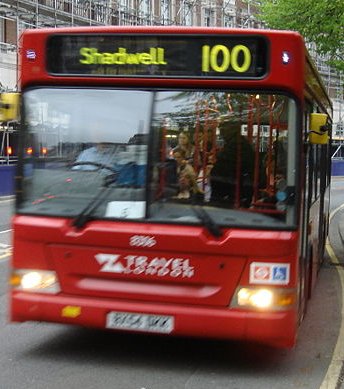
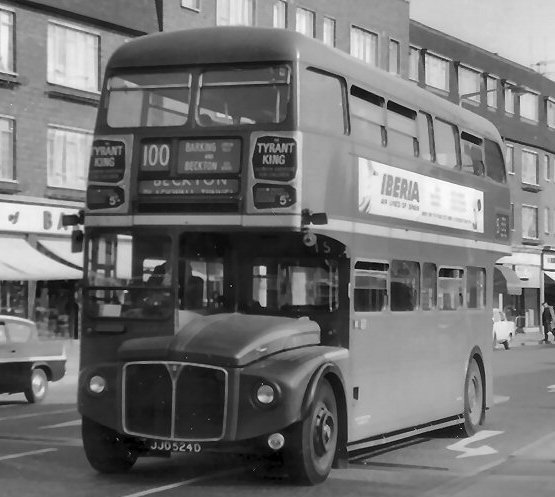 The 100 runs
from Shadwell (Cable Street, outside St George's Town Hall) via
Wapping, Aldgate, London Wall and St Paul's to Elephant and Castle. The
original 100 route, until 1972, was a workmen's bus from Barking
to Beckton Gasworks - pictured right. It then became the number of various vintage bus
routes through the City and West End [plate below].
The 100 runs
from Shadwell (Cable Street, outside St George's Town Hall) via
Wapping, Aldgate, London Wall and St Paul's to Elephant and Castle. The
original 100 route, until 1972, was a workmen's bus from Barking
to Beckton Gasworks - pictured right. It then became the number of various vintage bus
routes through the City and West End [plate below].
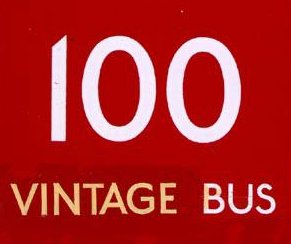
The current service is run by Abellio.
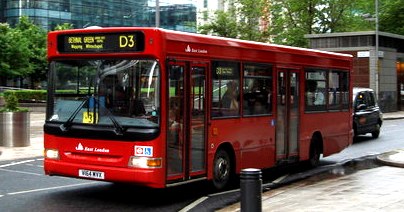 The D3
runs from Crossharbour on the Isle of Dogs, via Canary Wharf,
Limehouse and Wapping and along Cannon Street Road, stopping near the
Royal London Hospital and then via Bethnal Green to the London Chest
Hospital. It is one of a series of 'Docklands' routes and is run by
the East London Bug Group.
The D3
runs from Crossharbour on the Isle of Dogs, via Canary Wharf,
Limehouse and Wapping and along Cannon Street Road, stopping near the
Royal London Hospital and then via Bethnal Green to the London Chest
Hospital. It is one of a series of 'Docklands' routes and is run by
the East London Bug Group.
The 339
runs from Shadwell DLR station through Stepney and Mile End to Fish
Island, Old Ford, and is operated by First Capital. (The original 339
was a 'country' bus between Harlow and Warley.)
Docklands Light Railway
 When Docklands was redeveloped, the search was on a transport system to link it to the City, and the London Docklands Development Corporation chose a 'cheap and cheeerful' light metro system, with driverless trains. Opened in 1987, the original routes of the DLR
were from Tower Gateway in the west, using two elevated tracks of the
former London and Blackwall Railway (see above), with stations at
Shadwell, Limehouse [formerly Stepney] - with connections to the
Fenchurch Street lines - and Westferry, where the line split on new
concrete viaducts to Stratford via Poplar, and through Canary Wharf to
Island Gardens (Isle of Dogs). A western link to the Underground
network at Bank was then created, and there have been several eastern
extensions and new lines, and more are under construction.
When Docklands was redeveloped, the search was on a transport system to link it to the City, and the London Docklands Development Corporation chose a 'cheap and cheeerful' light metro system, with driverless trains. Opened in 1987, the original routes of the DLR
were from Tower Gateway in the west, using two elevated tracks of the
former London and Blackwall Railway (see above), with stations at
Shadwell, Limehouse [formerly Stepney] - with connections to the
Fenchurch Street lines - and Westferry, where the line split on new
concrete viaducts to Stratford via Poplar, and through Canary Wharf to
Island Gardens (Isle of Dogs). A western link to the Underground
network at Bank was then created, and there have been several eastern
extensions and new lines, and more are under construction.
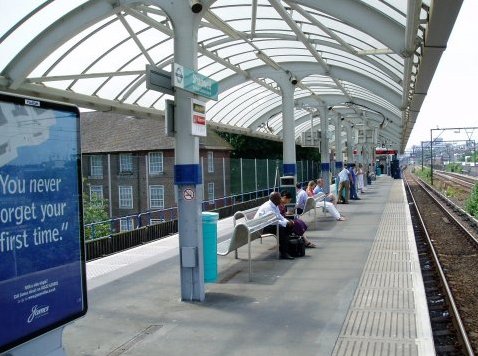
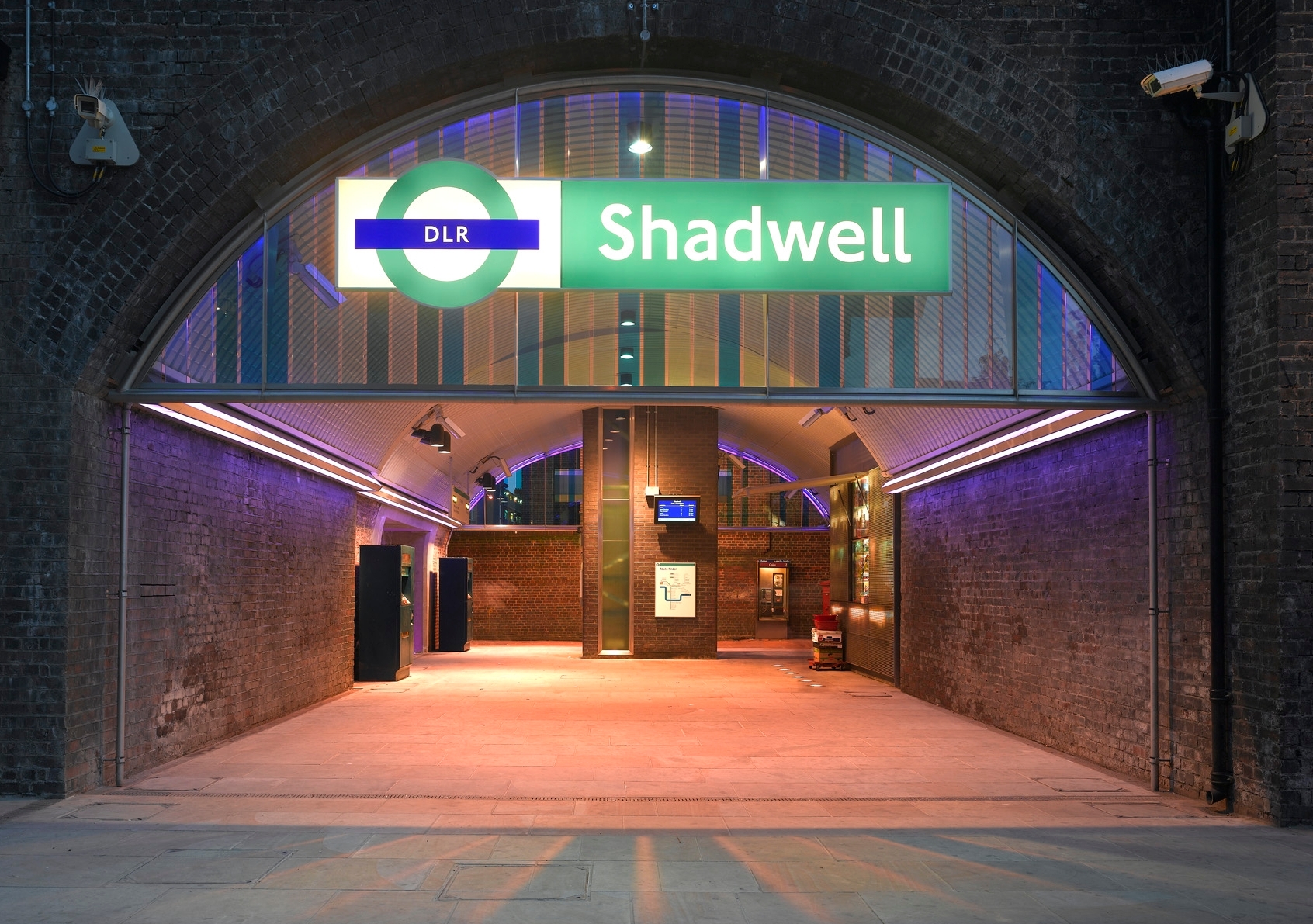 Demand
quickly outstripped provision: originally run by single-car units,
two-car trains were introduced, and in 2009, to deal with overcrowding,
all platforms were lengthened for the introduction of three-car trains [pictured above], and stations were upgraded in other ways. Pictured are the platforms and the new façade at Shadwell.
Demand
quickly outstripped provision: originally run by single-car units,
two-car trains were introduced, and in 2009, to deal with overcrowding,
all platforms were lengthened for the introduction of three-car trains [pictured above], and stations were upgraded in other ways. Pictured are the platforms and the new façade at Shadwell.
The system is run by Serco Docklands Ltd, under a concession from Transport for London, and is part of the Oyster network, providing through travel on other TfL lines, now including London Overground.
The future: Crossrail
Crossrail
is a major scheme for an additional underground rail route crossing
central London to relieve congestion on existing lines, and extending
above ground to the east and west. At Whitechapel (interchanging with
existing lines) it will diverge to Stratford and beyond to the north,
and via Canary Wharf to Abbey Wood and beyond in the south. It will not
therefore pass through the parish, but when completed will certainly
have a major impact on local infrastructures.
Back to Home page | Back to History page | Back to Cable Street